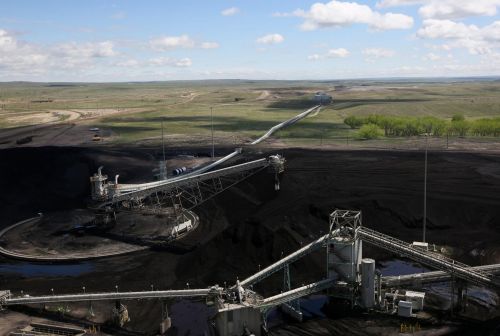本文转自《Star Tribune》发表的题为“UW receives $10 million to study carbon dioxide storage in coal country”的报道。
作者:Heather Richards 邮箱:Heather.Richards@trib.com
日期:2018.05.29
原文链接:http://trib.com/business/energy/uw-receives-million-to-study-carbon-dioxide-storage-in-coal/article_aaeee6bc-a3ca-5b09-8722-af1f84e6dfc6.html

Conveyors move coal brought in by rail to the Dave Johnston Power Plant in Glenrock. The University of Wyoming received $10 million to study whether carbon dioxide can be captured from coal-burning power plants and stored underground.
输送机将通过铁路运送来的煤送到格伦罗克的戴夫约翰斯顿发电厂。 怀俄明大学收到1000万美元,用于研究是否可以从燃煤电厂捕获二氧化碳并将其储存在地下。
Taking gas out of the ground is big business in Wyoming, but pumping gas back into it might provide another opportunity for the state.
在怀俄明州开采天然气是一件大事,但将气体注入地下可能会为该州提供另一个机会。
The U.S. Department of Energy has given the University of Wyoming nearly $10 million to see if 50 million tons of carbon dioxide can be stored underground north of Gillette.
美国能源部向怀俄明大学捐赠近1000万美元,用于查看Gillette以北地下是否可以储存5000万吨二氧化碳。
The greenhouse gas poses a long-term risk to Wyoming, the largest coal producing state in the country. About 40 percent of the coal burned in U.S. power plants comes from Wyoming’s Powder River Basin and the industry is a crucial piece of the state’s economy.
温室气体对怀俄明这个美国最大的煤炭生产州构成长期风险。美国电厂中约有40%的煤炭来自怀俄明州的粉河盆地,该行业是该州经济至关重要的一部分。
However, from current and pending regulations on carbon dioxide emissions to customer preference for cleaner energy sources in other parts of the country, a host of factors threaten the future use of Wyoming coal.
然而,从目前和未来的二氧化碳排放规定到消费者对该国其他地区清洁能源的偏好,许多因素威胁到未来怀俄明州煤炭的使用。
“Finding ways to make traditional uses of coal cleaner and more efficient, along with exploring ways to create new markets for coal, are important objectives for Wyoming, the nation’s No. 1 coal producer,” said Mark Northam, director of UW’s School of Energy Resources, in a statement.
“设法使传统煤炭更洁净和更高效的利用,同时探索如何为煤炭开辟新的市场,这是美国第一大煤炭生产商怀俄明州的重要目标,”美国大学能源学院院长马克诺瑟姆在一份声明中说道。
The purpose of the UW study is to see if the troublesome gas can be captured from coal-burning plants and stored underground at a utility-scale site in Gillette near the Dry Fork Station power plant.
UW研究的目的是查看是否可以从燃煤电厂获取有害的气体,并将其储存在位于Dry Fork Station发电厂附近的Gillette的公用事业规模地点。
It’s no surprise that Dry Fork’s owner, Basin Electric Power Cooperative, is involved in the project. Basin is also one of the key partners in the Wyoming Integrated Test Center, a series of research bays attached to Dry Fork Station, which are now hosting tenants studying how to take the gas and turn it into products like concrete.
Dry Fork的所有者,盆地电力合作社参与该项目并不奇怪。该盆地也是怀俄明州综合测试中心的主要合作伙伴之一,该综合测试中心连接着Dry Fork Station,它们现在主持研究如何使用天然气并将其转化为混凝土等产品。
Wyoming’s Legislature, at the request of Gov. Matt Mead, put $15 million down for the Integrated Test Center, spurred by the notion that if capturing carbon is going to keep utilities from turning their back on Wyoming coal, there has to be both a cheaper way to do it and an industry hungry for the gas.
怀俄明州立法机关,在州长马特米德的要求,为综合测试中心投入了1500万美元,这是因为如果碳捕获将阻止公用事业公司拒绝在怀俄明州的煤矿上运营,那么必须同时降低成本这样做的方式和一个渴望天然气的行业。
For some time, a potentially eager buyer of carbon dioxide has been oil and gas producers. Wyoming, with its many stripper wells and older oil fields, is a prime candidate for using carbon dioxide in enhanced oil recovery — the most well-known and economic use of captured gas. Companies like Denbury Resources are capitalizing on this relationship through pipeline development, while exploration and production firms like Fleur De Lis are actively using carbon dioxide in the oil patch.
一段时间以来,石油和天然气生产商一直是购买二氧化碳的潜在者。怀俄明州拥有许多油井和老油田,是采用注入二氧化碳提高原油采收率的最佳候选者 - 这是捕获天然气最著名和最经济的用途。像Denbury Resources这样的公司正在通过管道开发利用这种关系,而像Fleur De Lis这样的勘探和生产公司正在油田中积极使用二氧化碳。
But the cost of carbon capture has not decreased enough for this marriage of coal plants and oil fields to take off, according to industry.
但业内人士表示,碳捕集的成本并没有降低,因此煤电厂和油田的合作就搁置了。
Storage is the other half of the carbon capture approach, given the amount of greenhouse gasses coming from the utility sector and the lack, currently, of economic ways to capture and transport gas to the oil fields.
考虑到来自公用事业部门的温室气体数量以及目前缺乏捕获和运输天然气到油田的经济方法,储存是碳捕集方法的另一半。
Ultimately, it all comes back to coal.
最终,这一切都回到了煤炭。
“Projects such as this will help determine viable alternatives for carbon storage that will help ensure the continued use of this nation’s abundant coal resource by creating and expanding options for managing our carbon footprint,” said Matt Greek, Basin Electric senior vice president of research, development and technology, in a statement.
“这样的项目将有助于确定碳储存的可行替代方案,这将有助于确保通过创建和扩大碳管理选项来继续使用该国丰富的煤炭资源,”盆地电气研究高级副总裁Matt Greek表示。
Dry Fork is state-of-the-art coal burning plant north of Gillette that went online in 2011. As a relatively new plant, its lifeline should extend decades.
Dry Fork是Gillette以北最先进的燃煤电厂,2011年上线。作为一个相对较新的工厂,其生命线应该延续数十年。
But like all other coal plants in the United State, both new and old, Dry Fork continues to release carbon dioxide into the atmosphere, about 2.8 million metric tons per year.
但像美国的所有其他煤炭工厂一样,无论是新老用户,Dry Fork都会继续向大气释放二氧化碳,每年约有280万吨。
The grant funding is available from the Department of Energy’s Carbon Storage Assurance Facility Enterprise initiative, which aims to find ways to safely harness utility-scale volumes of captured carbon dioxide underground. Other partners include oil services firm Schlumberger, the University of North Dakota’s Energy and Environmental Research Center, and UW’s Enhanced Oil Recovery Institute and Carbon Management Institute.
这笔资金来源于能源部的碳储存保证机制企业计划,该计划的目的在于设法安全地利用地下二氧化碳捕集量。其他合作伙伴包括斯伦贝谢石油服务公司,北达科他州能源与环境研究中心,以及威斯康星大学提高石油采收率研究所和碳管理研究所。
The total cost of the project, which will take place over two years, is $12.25 million, according to the University of Wyoming. In addition to the $9.77 million in federal money, partners will participate in cost sharing to the tune of $2.47 million.
根据怀俄明大学的数据,该项目将花费两年时间,总成本为1225万美元。除了970万美元的联邦资金外,合作伙伴还将参与费用分摊达到247万美元。
The Department of Energy’s CarbonSafe Initiative also sent money to Wyoming in 2016, when UW facilitated feasibility research on storing gas from the Jim Bridger Power Plant — the most powerful emitter of carbon dioxide in Wyoming’s power fleet — with about $2 million from the federal agency.
能源部的CarbonSafe计划也于2016年向怀俄明州发放了资金,当时,UW为联邦机构提供的约200万美元的Jim Bridger发电厂 - 怀俄明州最强大的二氧化碳排放国 - 的储存天然气的可行性研究提供了便利。